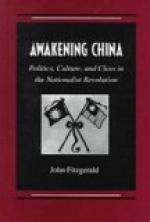W. A. P. M.
PEARL GROTTO, NEAR PEKING, August 8, 1906.]
Buddhist monasteries are to be seen on every hand. They are often subsidised by the state; and even at the tomb of Confucius a temple was erected called the “Hall of the Three Religions.” In it the image of [Page 109] Buddha is said to have occupied the seat of honour, but prior to the date of my visit it had been demolished.
Each of these religions has a hierarchy: that of Confucius with a lineal descendant of the Sage at its head; that of Lao-tse with Chang Tien-shi, the arch-magician, as its high priest; and, higher than all, that of Buddha with the Grand Lama of Tibet.
Under the house of Han a beginning was made in the institution of civil service examinations—a system which has continued to dominate the Chinese intellect down to our time; but it was not fully developed until the dynasty of T’ang. Belles-lettres made a marked advance. The poetry of the period is more finished [Page 110] than that of the Chous. Prose composition, too, is vigorous and lucid. The muse of history claims the place of honour. Sze-ma Ts’ien, the Herodotus of China, was born in this period. A glory to his country, the treatment Sze-ma Ts’ien received at the hands of his people exposes their barbarism. He had recommended Li Ling as a suitable commander to lead an expedition against the Mongols. Li Ling surrendered to the enemy, and Sze-ma Ts’ien, as his sponsor, was liable to suffer death in his stead. Being allowed an alternative, he chose to submit to the disgrace of emasculation, in order that he might live to complete his monumental work—a memorial better than sons and daughters. A pathetic letter of the unfortunate general, who never dared to return to China, is preserved amongst the choice specimens of prose composition.
Not content with the Great Wall for their northern limit nor with the “Great River” for their southern boundary, the Hans attempted to advance their frontiers in both directions. In the north they added the province of Kansuh, and in the other direction they extended their operations as far south as the borders of Annam; but they did not make good the possession of the whole of the conquered territory. Szechuen and Hunan were, however, added to their domain. The latter seems to have served as a penal colony rather than an integral portion of the Empire. A poem by Kiayi, an exiled statesman (200 B. c.), is dated from Changsha, its capital.[*]
[Footnote *: See “Chinese Legends and Other Poems,” by W. A. P. Martin.]
In the south the savage tribes by which the Chinese [Page 111] were opposed made a deep impression on the character of the people, but left no record in history. Not so with the powerful foe encountered in the north. Under the title of Shanyu, he was a forerunner of the Grand Khan of Tartary—claiming equality with the emperors of China and exchanging embassies on equal terms. His people, known as the Hiunghu, are supposed to have been ancestors of the Huns.




